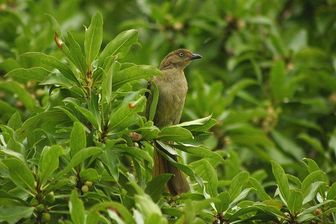Sombre Greenbul
The Sombre Greenbul is 15–18 cm long, with mainly dull greyish olive-green plumage, paler on the underparts than above. It has a white iris. The sexes are similar in plumage, but juveniles are even duller than the adult and have dark eyes.

Original source: Flickr user scarymonkeyshow . Photo uploaded to commons by user ltshears
Author: Flickr user scarymonkeyshow . Photo uploaded to commons by user ltshears
The Sombre Greenbul is classified as Least Concern. Does not qualify for a more at risk category. Widespread and abundant taxa are included in this category.
The Sombre Greenbul, Andropadus importunus, is a member of the bulbul family of passerine birds. It is a resident breeder in coastal bush, evergreen forest and dry shrub land in eastern Africa from Ethiopia to the Cape in South Africa. More
The Sombre Greenbul is a resident breeder in coastal bush, evergreen forest and dry shrub land in eastern Africa from Ethiopia to the Cape in South Africa. Though it’s a common bird, as anyone who’s looked for them will now it does tend to stay hidden in foliage and is more often heard than seen. More
The Sombre Greenbul is a resident breeder in coastal bush, evergreen forest and dry shrub land in eastern Africa from Ethiopia to the Cape in South Africa. More
sombre greenbul Kruger National Park birds The Sombre Greenbul (Latin name Andropadus importunus) is described in Roberts Birds of Southern Africa, 7th Edition. This bird has a unique Roberts number of 572 and you will find a full description of this bird on page 770 also a picture of the Sombre Greenbul on page 817. The Sombre Greenbul belongs to the family of birds classified as Pycnonotidae. More
The Sombre Greenbul is a common bird, which tends to stay hidden in foliage and is more often heard than seen. It is usually found in pairs or small groups foraging for insects, fruit and small snails. The Sombre Greenbul is a vocal species, and the most typical call is a monotonous, ringing phrase starting with a penetrating single whistle weeeewee, followed by a jumbled chortle and ending off with a rather plaintive, drawn out whistle willy. http://en.wikipedia. More
The Sombre Greenbul has a uniform dull greyish olive-green plumage. The underparts are paler grey, tinged green and mostly olive green. Unlike the bulbuls, it does not have a white eye. This species is more often heard than seen in the forest and coastal bush that it inhabits. Unlike the bulbuls it tends to be shy and stay hidden in foliage. It is found in Forest, coastal and riverine bush. More
a very distraught sombre greenbul (Andropadus importunus) was being chased. The behaviour displayed was typical as one bird chased the sombre greenbul the other attended the nest we assumed the female to lay her eggs but the greenbull would return chasing the female from her nest. We watched these birds for a good 20 minutes but neither of them let up and as we left the jacobin was still trying to lay its eggs but to no avail. More
Andropadus importunus - Sombre Greenbul - Bulbul importun - 18/02/10 on Flickriver Large button: preview: Andropadus importunus - Sombre Greenbul - Bulbul importun - 18/02/10 on Flickriver Dynamic badge: Use Flickriver Badge Creator to create a badge linking to any Flickriver view example: iosart - View my most interesting photos on Flickriver close link panel Add a quick comment Login now Postcancel More
Distribution of Sombre greenbul in southern Africa, based on statistical smoothing of the records from first SA Bird Atlas Project (© Animal Demography unit, University of Cape Town; smoothing by Birgit Erni and Francesca Little). Colours range from dark blue (most common) through to yellow (least common). See here for the latest distribution from the SABAP2. Food It eats mainly eats fruit, foraging in the foliage of trees and bushes, regularly singing its distinctive call. More
Sombre Greenbul (Andropadus importunus) by Don Jones. More
There are 2 races of Zanzibar Sombre Greenbul present in Kenya. The Eastern race Andropadus importunus insularis (pictured above) is the more easterly race, found in the coastal lowlands, while A. i. fricki is known from the central regions around Embu, Meru and Thika. In adult plumage the 2 races can be distinguished from the eye, A. i. insularis lacks the yellow eye-ring of A. i. fricki (juvenile insularis lose their eye-ring as they moult into adult plumage). More
Family : Pycnonotidae
Genus : Andropadus
Species : importunus
Authority : (Vieillot, 1818)

